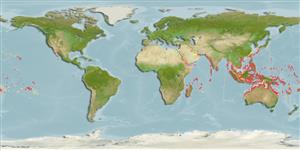Common names from other countries
Environment: milieu / climate zone / depth range / distribution range
Écologie
Récifal; profondeur 6 - 30 m (Ref. 8294). Tropical; 36°N - 29°S, 32°E - 110°W (Ref. 848)
Indo-Pacific: East Africa including Red Sea to Polynesia, north to Japan and south to Australia.
Length at first maturity / Taille / Poids / Âge
Maturity: Lm ? range ? - ? cm Max length : 5.0 cm WD mâle / non sexé; (Ref. 269)
Description synthétique
Morphologie
Formation: flat to hemispherical, may exceed 5 m across; phaceloid to flabello-meandroid with irregularly dividing valleys. Several colonies in different colors and polyp mantle textures may fuse to form a single composite stand. Septa: thickness taper from wall to columella, with tall sharp teeth. Polyps: thick and fleshy when retracted; mantles either smooth or rough. Color: uniform, or with 2 or more colors concentric to mouths or valley walls; corallites of the same colony share the same coloration (Ref. 848). This species is one of the two species of Lobophyllia and is similar to L. corymbosa, which is very similar to the first in overall growth form. The corallites are phaceloid, separated except at the base and form long meanders 1 to 5 cm in width. The septa and costae are covered with exsert, sharp dentations (Ref. 269).
Maximum depth from Ref. 100939. Occurs in upper reef slopes (Ref. 848). Zooxanthellae (Ref. 19). Has high bleaching level and high estimated mortality in Palau (Ref. 66144).
Life cycle and mating behavior
Maturité | Reproduction | Frai | Œufs | Fécondité | Larves
Hermaphroditic (Refs. 113708, 113712). Mature gametes are shed into the coelenteron and spawned through the mouth. Life cycle: The zygote develops into a planktonic planula larva. Metamorphosis begins with early morphogenesis of tentacles, septa and pharynx before larval settlement on the aboral end (Ref. 833).
Hodgson, G. 1998. (Ref. 269)
Statut dans la liste rouge de l'IUCN (Ref. 130435)
statut CITES (Ref. 108899)
Not Evaluated
Utilisations par l'homme
| FishSource |
Outils
Sources Internet
Estimates based on models
Preferred temperature
(Ref.
115969): 25 - 29.3, mean 28.4 (based on 3303 cells).
Vulnérabilité
Low vulnerability (10 of 100).
Catégorie de prix
Unknown.
